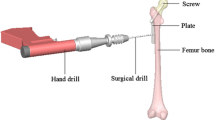Abstract
Purpose
Bone drilling causes an increase in bone temperature, and a temperature above 47°C is critical because it causes thermal bone necrosis. Thermal osteonecrosis is common with the drill diameter of ≥4.5 mm without cooling. The aim of this study was to determine the increase of bone temperature during drilling using newly contructed two-step and internally cooled drills.
Methods
An experiment was set up according to a central composite design. An internally cooled drill (3.4 mm and 4.5 mm) and a two-step drill (2.5/3.4 and 3.4/4.5 mm) were used in combination with feed rates of (0.02, 0.04, 0.10, 0.16 and 0.18 mm/rev) and cutting speeds (1.18, 10.68, 33.61, 56.55 and 66.05 m/min) with and without cooling with water of 24°C. Bone temperatures were measured with thermocouples. Drilling was performed on pig diaphyses with a three-axis mini milling machine.
Results
Bone temperatures in all combinations of parameters with internal cooling were below the critical 47°C (p = 0.05). The highest temperatures were detected using a 4.5-mm drill (40.5°C). A statistically significant effect other than cooling was found with the drill diameter and feed. A drill diameter of 3.4 mm with internal cooling developed a maximum temperature of 38.5°C and without cooling 46.3°C. For the same conditions a drill with diameter of 4.5 mm reached temperatures of 40.5°C and 55.7°C, respectively. The effect of feed rate is inversely proportional to the increase in bone temperature. With the feed rate 0.16 mm/rev, temperature was below critical even using the 4.5-mm drill (46.4°C, p = 0.05). Using the 3.4-mm drill all temperatures were below critical (46.2°C, p = 0.05). The two-step drill compared to a standard drill with the same diameter did not show statistical differences in maximum bone temperatures for all combinations of parameters (p = 0.05).
Conclusions
A two-step drill does not have any advantages over a standard twist drill of the same diameter. An internally cooled drill causes a significantly smaller increase of bone temperature during drilling with water of 24°C. An internally cooled drill is currently the 'ideal' drill for traumatology/orthopaedics because it produces the smallest increase in bone drilling temperature. If internal cooling is used the regulation of other drilling parameters is of no importance.





Similar content being viewed by others
References
Eriksson AR, Albrektsson T (1983) Temperature threshold levels for heat-induced bone tissue injury: a vital-microscopic study in the rabbit. J Prosthet Dent 50:101–107
Ercoli C, Funkenbusch PD, Lee HJ, Moss ME, Graser GN (2004) The influence of drill wear on cutting efficiency and heat production during osteotomy preparation for dental implants: a study of drill durability. Int J Oral Maxillofac Implants 19:335–349
Matthews LS, Hirsch C (1972) Temperature measured in human cortical bone when drilling. J Bone Joint Surg Am 54:297–308
Chacon GE, Bower DI, Larsen PE, McGlumphy EA, Beck FM (2006) Heat production by 3 implant drill systems after repeated drilling and sterilization. J Oral Maxillofac Surg 64:265–269
Eriksson RA, Albrektsson T, Albrektsson B (1984) Heat caused by drilling cortical bone. Temperature measured in vivo in patients and animals. Acta Orthop Scand 55:629–631
Yacker MJ, Klein M (1996) The effect of irrigation on osteotomy depth and bur diameter. Int J Oral Maxillofac Implants 11:634–638
Eriksson RA, Adell R (1986) Temperatures during drilling for the placement of implants using the osseointegration technique. J Oral Maxillofac Surg 44:4–7
Kondo S, Okada Y, Iseki H, Hori T, Takakura K, Kobayashi A, Nagata H (2000) Thermological study of drilling bone tissue with a high-speed drill. Neurosurgery 46:1162–1168
Augustin G, Davila S, Mihoci K, Udiljak T, Vedrina DS, Antabak A (2008) Thermal osteonecrosis and bone drilling parameters revisited. Arch Orthop Trauma Surg 128:71–77
Sener BC, Dergin G, Gursoy B, Kelesoglu E, Slih I (2009) Effects of irrigation temperature on heat control in vitro at different drilling depths. Clin Oral Implan Res 20:294–298
Reingewirtz Y, Moncler S, Senger B (1997) Influence of different parameters on bone heating and drilling time in implantology. Clin Oral Implan Res 8:189–197
Jacob CH, Berry JT, Pope MH (1976) A study of the bone machining process—drilling. J Biomech 9:343–349
Aerssens J, Boonen S, Lowet G, Dequeker J (1998) Interspecies differences in bone composition, density and quality: potential implications for in vivo bone. Endocrinology 139:663–670
Sedlin ED, Hirsch C (1966) Factors affecting the determination of the physical properties of femoral cortical bone. Acta Orthop Scand 37:29–48
Natali C, Ingle P, Dowell J (1996) Orthopaedic bone drills—can they be improved? Temperature changes near the drilling face. J Bone Joint Surg Br 78:357–362
Bachus KN, Rondina MT, Hutchinson DT (2000) The effects of drilling force on cortical temperatures and their duration: an in vitro study. Med Eng Phys 22:685–691
Augustin G, Zigman T, Davila S et al (2011) Cortical bone drilling and thermal osteonecrosis. Clin Biomech, (Bristol, Avon). 2011 Nov 7. [Epub ahead of print]
Kirschner H, Meyer W (1975) Entwichlung einer Innenkuhlung fur chirurgische 1147 Bohrer. Dtsch Zahnaztl Zeitschrift 30:436–438
Benington IC, Biagioni PA, Briggs J, Sheridan S, Lamey PJ (2002) Thermal changes observed at implant sites during internal and external irrigation. Clin Oral Implan Res 13:293–297
Bubeck KA, García-López J, Maranda LS (2009) In vitro comparison of cortical bone temperature generation between traditional sequential drilling and a newly designed step drill in the equine third metacarpal bone. Vet Comp Orthop Traumatol 22:442–447
Acknowledgements
This experiment is a part of the scientific project: Biomechanics of fractures and fracture healing and is supported by The Ministry of Science, Education and Sports.
Conflict of interest
None.
Author information
Authors and Affiliations
Corresponding author
Rights and permissions
About this article
Cite this article
Augustin, G., Davila, S., Udilljak, T. et al. Temperature changes during cortical bone drilling with a newly designed step drill and an internally cooled drill. International Orthopaedics (SICOT) 36, 1449–1456 (2012). https://doi.org/10.1007/s00264-012-1491-z
Received:
Accepted:
Published:
Issue Date:
DOI: https://doi.org/10.1007/s00264-012-1491-z




